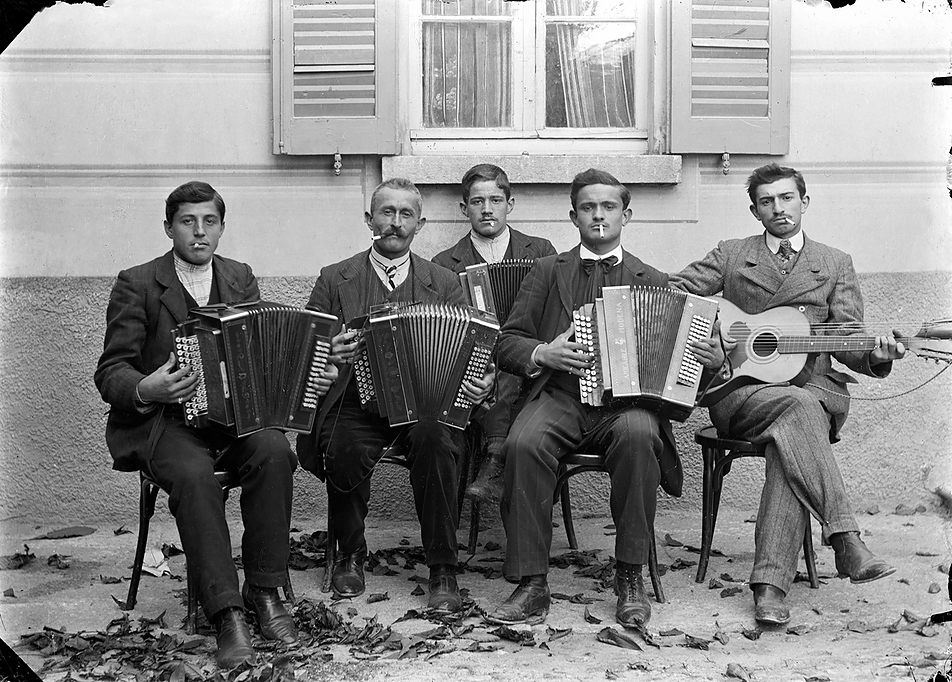

Roberto Donetta
Roberto Donetta was born on 6 June 1865 in Biasca, the last of 4 children of Carlo and Maria Donetta di Corzoneso, in the valley of Blenio.
Information on Donetta’s first twenty years of life is rather limited. The first sure news is the date of her marriage to Teodolinda Tinetti in 1886, from which seven children will be born.
Given the difficult economic situation Donetta is forced to emigrate, like most of her fellow citizens.
روبرتو دونيتا
ولد روبرتو دونيتا في 6 يونيو 1865 في بياسكا ، آخر 4 أطفال من كارلو وماريا دونيتا دي كورزونسو ، في وادي بلينيو.
معلومات عن أول عشرين سنة من حياة دونيتا محدودة نوعًا ما. الخبر الأول المؤكد هو تاريخ زواجها من Teodolinda Tinetti في عام 1886 ،
والذي سيولد منه سبعة أطفال.
نظرا للحالة الاقتصادية الصعبة ، اضطرت دونيتا للهجرة ، مثل معظم مواطنيها.
Starting from 1889 during the winter months he moved to Northern Italy to do the job of marroniio. After returning to the valley he assumes the role of military officer, a position he does not hold for long. In 1894, in fact, he moved to London where he remained until 1895.
To make ends meet Donetta engages as a street vendor of seeds. At the same time he began to take an interest in photography, thanks also to the sculptor Dionigi Sorgesa, who, in addition to giving him first notions, also lends him a camera.
ابتداء من عام 1889 خلال أشهر الشتاء انتقل إلى شمال إيطاليا للقيام بمهمة marroniio.
بعد العودة إلى الوادي يفترض دور الضابط العسكري ، وهو منصب لا يحتفظ به لفترة طويلة.
في عام 1894 ، في الواقع ، انتقل إلى لندن حيث بقي حتى عام 1895.
لتدبير احتياجاتها ، تلتقي دونيتا كبائع متجول للبذور.
وفي الوقت نفسه بدأ يهتم بالتصوير الفوتوغرافي ، ويرجع الفضل في ذلك إلى النحات ديونيجي سورجيزا ،
الذي يقدم له ، بالإضافة إلى إعطائه أفكاره الأولى ، كاميرا.
In 1901 he settled in Casserio, a fraction of Corzoneso, where he spent the rest of his life. A life of sacrifice: to feed the family works as a marronaio, seller of seeds and photographer. It is on these occasions that he fixes on the photographic plates the events that would transform the valley, as well as weddings, baptisms, funerals. But Roberto Donetta also knew how to capture everyday life in its various aspects. Among the most recurrent themes are work, nature and hobbies. Of his images strikes the high photographic quality, which today places his work far beyond the mere recording of events in the valley. His immense curiosity, combined with a marked personality, leads him to audacious, very personal formal experiments, which make him rightfully among the leading photographers of his time in the early 20th century Ticino.
في عام 1901 استقر في Casserio ، وهو جزء من Corzoneso ، حيث قضى بقية حياته.
حياة من التضحية: لإطعام الأسرة يعمل بمثابة marronaio ، بائع البذور والمصور.
في هذه المناسبات ، يقوم بتصحيح الأحداث على لوحات الصور الفوتوغرافية التي من شأنها تحويل الوادي ،
وكذلك حفلات الزفاف ، والتعميد ، والجنازات.
لكن روبرتو دونيتا كان يعرف أيضًا كيفية التقاط الحياة اليومية في جوانبها المختلفة.
من بين الموضوعات الأكثر تكرارًا هي العمل والطبيعة والهوايات. من صوره تضرب جودة التصوير العالية ،
والتي تضع أعماله اليوم أبعد بكثير من مجرد تسجيل الأحداث في الوادي. إن فضوله الكبير ،
مع شخصيته المميزة ، يقود به إلى تجارب رسمية جريئة وشخصية للغاية ،
مما يجعله من بين المصورين الرائدين في وقته في أوائل القرن العشرين في تيسينو.
Roberto Donetta died in 1932, in poverty and in solitude in the Casa Rotonda di Casserio, at the age of 67. The family had abandoned him for years, to move to France.
The authorities seize the few things left to pay the old debts and the expenses of the funeral. The sale of the auction is successful, while the 5000 glass sheets remain unsold, which no one withdraws and remain available to the municipality of Corzoneso, a municipality to which the Donetta Archives belong today.
توفي روبرتو دونيتا في عام 1932 ، في فقر وعزلة في كاسا روتوندا دي كاسّيرو ، عن عمر يناهز ال 67.
وقد تخلت عنه العائلة لسنوات ، للانتقال إلى فرنسا.
وتستولي السلطات على بعض الأشياء المتبقية لدفع الديون القديمة ونفقات الجنازة.
بيع المزاد ناجح ، في حين أن الأغطية الزجاجية التي يبلغ عددها 5000 ورقة لا تزال غير مباعة ،
والتي لا أحد يسحبها ويظل متاحا لبلدية كورزونسو ، وهي بلدية تنتمي إليها سجلات دونيتا اليوم.













